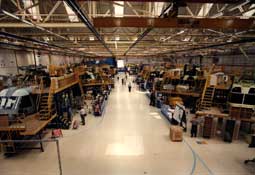 |
|

Westland History -
|
As the Lynx established itself with overseas orders, a decision was made to launch a larger aircraft, based on Lynx dynamic components as a private venture on the civil market. This was to be the 12000lb/14 passenger Westland 30. The W30 met with some initial success in the UK and USA, but the expected orders never materialised in time to fill the production gap which was predicted once the UK military orders had been delivered. The mid 1980s proved to be a difficult time for Westland. On the one hand there was a need to find a suitable partner to invest capital, sufficient to sustain the company over the period when a new product could be brought on line. At the same time the company was making considerable investment in composite blade technology and design of a replacement for the Sea King. Westland favoured a proposal for a major link with Sikorsky but the then Secretary of State for Defence, Micheal Hesseltine, preferred a European option. The Westland dilemma made national news at the time, but the link with Sikorsky went ahead and Westland survived. Westland had already entered an agreement with the Italian firm Agusta, to collaborate in the design, development and production of a new large helicopter to meet the requirement for a Sea King replacement. The two companies formed a joint company, EH Industries, specifically to produce the EH101, a multi-role helicopter designed to meet naval, military utility and civil requirements.
The EH101 development programme progressed well, and in 1991 the Ministry of Defence placed an order for 44 anti-submarine warfare aircraft designated EH101 Merlin HM Mk1. Following a competition, the prime contract was placed with a consortium led by the US company IBM, supported by Westland, in preference to a rival consortium led by British Aerospace and GEC Marconi. The need for the competition and the involvement of IBM as Westland's partner was because neither Westland or EHI were in a position to satisfy the MoD requirement that the prime contractor must have sufficient resources to underwrite the value of the whole £1.5 billion contract. The engineering company GKN had been a major shareholder in the Westland Group since 1987 and was one of the Groups strongest supporters. Sikorsky's parent company, United Technologies, was the other significant shareholder and in 1994 it decided to sell its holding. GKN bought the UTC shares and launched a successful take-over bid for Westland.
In 1998 GKN and Finnemeccanica announced that they were starting negotiations to create a joint venture company by combining their respective helicopter companies, Westland and Agusta. Those negotiations were successfully concluded in July 2000. The company AgustaWestland, will be the second largest helicopter company in the world, with a turnover of more than US$2 Billion and a workforce of some 10,000 people. By retaining the name Westland, the new company is perpetuating the proud heritage that has been associated with that name since Sir Ernest Petter made his first approach to the admiralty in 1915.
|
|
COPYRIGHT © and all other RIGHTS in these pages are reserved by AGUSTAWESTLAND LIMITED.

 There followed an interesting turn of events whereby at the time when the firms financial future had been in doubt, the
There followed an interesting turn of events whereby at the time when the firms financial future had been in doubt, the  Re-named GKN Westland Helicopters in 1995, the substantial financial muscle of GKN enabled the company to bid successfully as prime contractor for the £600 million Support Helicopter contract for the RAF (
Re-named GKN Westland Helicopters in 1995, the substantial financial muscle of GKN enabled the company to bid successfully as prime contractor for the £600 million Support Helicopter contract for the RAF ( previous
previous